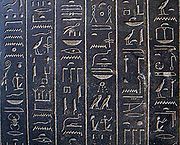
Ankhnesneferibre
Encyclopedia
Ankhnesneferibre held the office of Divine Adoratrice of Amun
(or God's Wife of Amun) during the 26th Dynasty of Egypt
from around 586 to 525 BC. During the same time, she also held the office of God's Wife of Amun
, which was the highest office in the priest
hood of the temple of Amun in Thebes
.
 The title, Divine Adoratrice of Amun, conveyed even more political authority than the earlier office especially during the Late Libyan period through to the Kushite Dynasty 25 and saite Dynasty 26 period. Ankhnesneferibre was the daughter of Psamtik II and his wife Takhuit. Ankhesenneferibre was dispatched to Thebes and adopted by her predecessor in this office, Nitocris I as a stela from Karnak records. Eight years later, in Year 4 of her brother Apries
The title, Divine Adoratrice of Amun, conveyed even more political authority than the earlier office especially during the Late Libyan period through to the Kushite Dynasty 25 and saite Dynasty 26 period. Ankhnesneferibre was the daughter of Psamtik II and his wife Takhuit. Ankhesenneferibre was dispatched to Thebes and adopted by her predecessor in this office, Nitocris I as a stela from Karnak records. Eight years later, in Year 4 of her brother Apries
's reign (c.586 BC), she formally assumed the office of Divine Adoratrice of Amun herself when Nitocris I died. Henceforth, she would govern Thebes
for a period of 60 years until the Persian conquest of Egypt in 525 BC. After the Persians captured Egypt, the office of the Divine Adoratrice of Amun was abolished and Ankhnesneferibre disappears from history. She is depicted in a number of statues and her black basalt sarcophagus was subsequently reused in Deir el-Medina during the Ptolemaic period by a man named Pymentu. Her sarcophagus is today located in the British museum.
Ankhnesneferibre's tomb can be found in the complex of Medinet Habu
.
Divine Adoratrice of Amun
The Divine Adoratrice of Amun was a second title created for the chief priestess of the ancient Egyptian deity, Amun. During the first millennium BCE, when the holder of this office exercised her largest measure of influence, her position was an important appointment facilitating the transfer of...
(or God's Wife of Amun) during the 26th Dynasty of Egypt
Twenty-sixth dynasty of Egypt
The Twenty-sixth Dynasty of Egypt was the last native dynasty to rule Egypt before the Persian conquest in 525 BC . The Dynasty's reign The Twenty-sixth Dynasty of Egypt (also written Dynasty XXVI or Dynasty 26) was the last native dynasty to rule Egypt before the Persian conquest in 525 BC...
from around 586 to 525 BC. During the same time, she also held the office of God's Wife of Amun
God's Wife of Amun
God's Wife of Amun was the highest ranking priestess of the Amun cult, an important Ancient Egyptian religious institution centered in Thebes during the Egyptian 25th and 26th dynasties...
, which was the highest office in the priest
Priest
A priest is a person authorized to perform the sacred rites of a religion, especially as a mediatory agent between humans and deities. They also have the authority or power to administer religious rites; in particular, rites of sacrifice to, and propitiation of, a deity or deities...
hood of the temple of Amun in Thebes
Thebes, Egypt
Thebes is the Greek name for a city in Ancient Egypt located about 800 km south of the Mediterranean, on the east bank of the river Nile within the modern city of Luxor. The Theban Necropolis is situated nearby on the west bank of the Nile.-History:...
.

Apries
Apries is the name by which Herodotus and Diodorus designate Wahibre Haaibre, Ουαφρης , a pharaoh of Egypt , the fourth king of the Twenty-sixth dynasty of Egypt. He was equated with the Waphres of Manetho, who correctly records that he reigned for 19 years...
's reign (c.586 BC), she formally assumed the office of Divine Adoratrice of Amun herself when Nitocris I died. Henceforth, she would govern Thebes
Thebes, Egypt
Thebes is the Greek name for a city in Ancient Egypt located about 800 km south of the Mediterranean, on the east bank of the river Nile within the modern city of Luxor. The Theban Necropolis is situated nearby on the west bank of the Nile.-History:...
for a period of 60 years until the Persian conquest of Egypt in 525 BC. After the Persians captured Egypt, the office of the Divine Adoratrice of Amun was abolished and Ankhnesneferibre disappears from history. She is depicted in a number of statues and her black basalt sarcophagus was subsequently reused in Deir el-Medina during the Ptolemaic period by a man named Pymentu. Her sarcophagus is today located in the British museum.
Ankhnesneferibre's tomb can be found in the complex of Medinet Habu
Medinet Habu (temple)
Medinet Habu is the name commonly given to the Mortuary Temple of Ramesses III, an important New Kingdom period structure in the location of the same name on the West Bank of Luxor in Egypt...
.

